Geoscience Reference
In-Depth Information
A Short History of
Human Population
Medieval
warm period
Holocene climate
optimum
2
1
Little Ice
Age
0
-1
-2
Before beginning the investigation of human/environmental in-
teractions, we should first consider the general history of human
population on Earth and how it is expected to change over the
course of your lifetime. This discussion provides important con-
text because it is directly related to resource consumption and the
ability of people to live in a particular place or consume resources
in a
sustainable
way—in other words, in a fashion that can con-
tinue for future generations. The
carrying capacity
of any given
landscape refers to the number of individuals who can live in
it without degrading the natural, social, cultural, and economic
environments beyond sustainable limits. A number of variables
directly associated with physical geography affect the carrying
capacity of the land, including climate, vegetation, and soils.
Average temperature over past
10,000 years = 15°C (59°F)
-3
-4
End of
last Ice
Age
Holocene
Epoch
-5
20,000 10,000 2,000
1,000
200
100
Now
Years ago
Figure 20.1 Global temperature changes over the past 20,000
years.
Note the rapid warming that occurred at the end of the
Pleistocene and the beginning of the Holocene. Average temper-
atures for this time span are compared to those of the present.
Technological Development and
Population Growth
A good place to begin a discussion of human population is the
end of the most recent ice age approximately 10,000 years ago.
As discussed in Chapter 9, the beginning of the Holocene Ep-
och marks the onset of what climatologists generally consider
to be “modern climate” (Figure 20.1). Warming in the early
Holocene was rapid, and by 9000 years ago the average Earth
temperature was about 4°C (~7°F) warmer than it had been
just a thousand years before. Although distinct warmer/drier
or cooler/wetter periods have occurred within the Holocene, as
shown in Chapter 9, the overall climate has generally been much
more hospitable to humans in the past 10,000 years than it was
at the end of the Pleistocene when glacial ice covered much of
the northern latitudes. Partially in response to this more favor-
able climate, human societies gradually became more complex.
People moved into newer areas and technological innovation in-
creased. A key result of this cultural evolution was the beginning
of agriculture about 8000 years ago in several widely separated
places on Earth. Prior to that time, people were essentially hunt-
ers and gatherers who spent much of their lives foraging for food.
The onset of agriculture was critical in human history be-
cause people could now grow their own food rather than search
for it. In so doing, humans gradually raised the carrying capacity
of many landscapes in such a way that larger numbers of people
could congregate in centralized locations that ultimately became
villages, towns, and even cities. With food more easily acces-
sible, people were freer to devote time to improving agricultural
techniques and inventing other things that made life easier. Ulti-
mately, these efforts led to the Industrial Revolution in the late
18th and early 19th centuries, during which numerous technolog-
ical advances led to mechanized production and increased supply
of goods. The social and economic changes brought on by the
Industrial Revolution ushered in the modern world as we know it.
Historical growth in human population during the past 10,000
years closely mirrors the evolution of human technology and so-
ciety. At the end of the most recent ice age, probably fewer than
500,000 people lived on Earth (Figure 20.2) and average life expec-
tancy may have been as short as 20 years. With the advent of ag-
riculture and enhanced food production, human population slowly
increased to approximately 500 million about 2000 years ago. The
population essentially held steady for another 1000 years and then
gradually increased to about 600 million around the year 1700,
with an average life expectancy of perhaps 40 years at that time.
World Population Growth Through History
8
7
6
5
4
3
Black Death—The Plague
2
1
0
2-5
million
years
7000
B.C.
5000
B.C.
3000
B.C.
1000
B.C.
A.D.
2025
A.D.
Figure 20.2 Global population change throughout human
history.
Note the dramatic increase during the past 200 years.
It is estimated that human population will be 9 billion by 2050.
(
Source
: Population Reference Bureau,
World Population: Toward
the Next Century
, 1994.)
Carrying capacity
The maximum number of organisms that
can live in a given area of habitat without degrading it and
causing social stresses that result in population decline.











